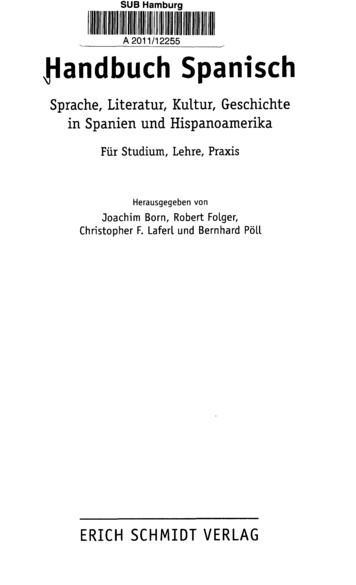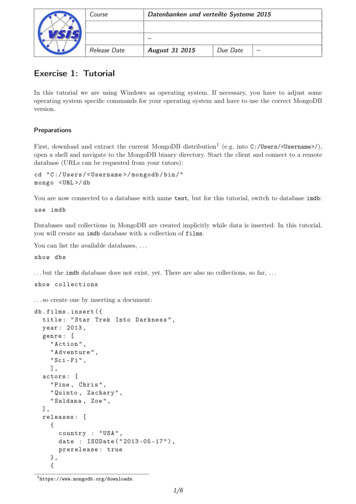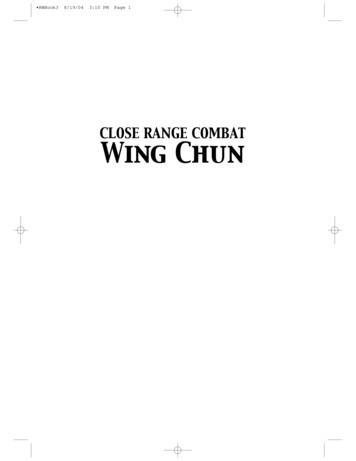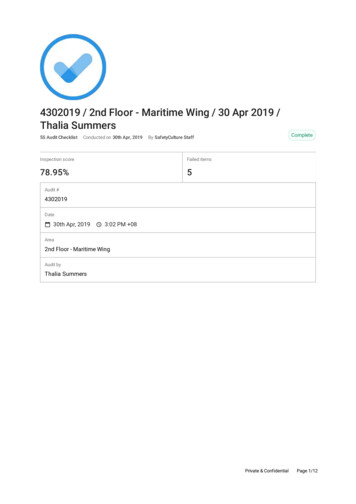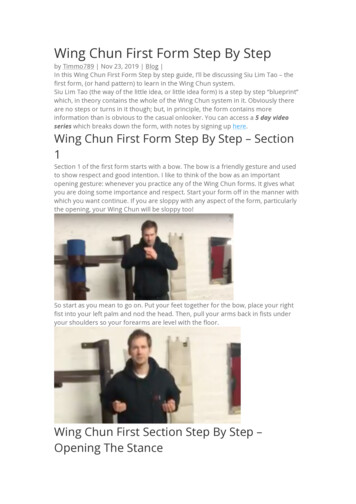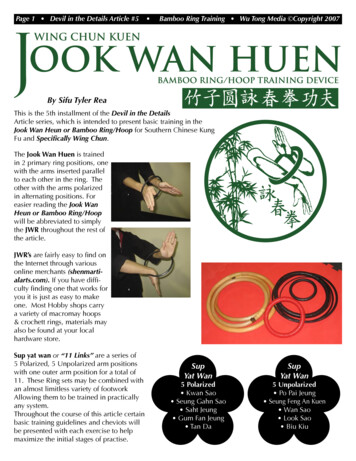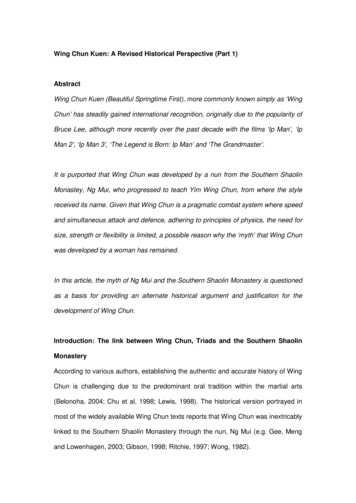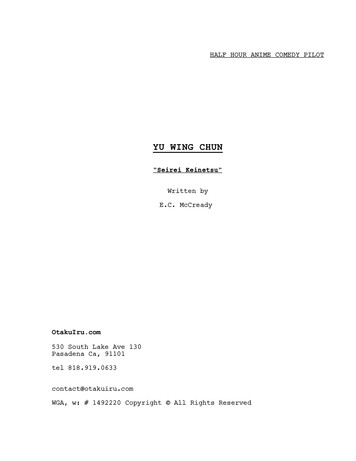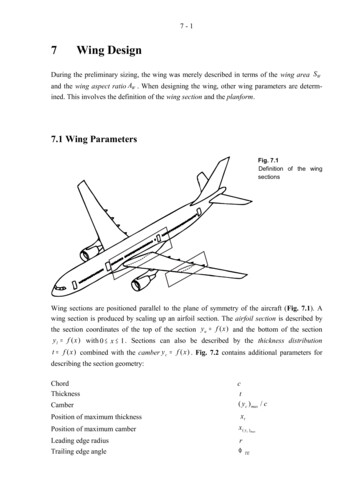
Transcription
7-17Wing DesignDuring the preliminary sizing, the wing was merely described in terms of the wing area SWand the wing aspect ratio AW . When designing the wing, other wing parameters are determ ined. This involves the definition of the wing section and the planform.7.1 Wing ParametersFig. 7.1Definition of the wingsectionsWing sections are positioned parallel to the plane of symmetry of the aircraft (Fig. 7.1). Awing section is produced by scaling up an airfoil section. The airfoil section is described bythe section coordinates of the top of the section y u f ( x ) and the bottom of the sectiony l f ( x ) with 0 x 1 . Sections can also be described by the thickness distributiont f ( x ) combined with the camber y c f ( x ) . Fig. 7.2 contains additional parameters fordescribing the section geometry:ChordThicknessCamberct( y c ) max / cPosition of maximum thicknessxtPosition of maximum camberx ( yc )maxLeading edge radiusTrailing edge anglerΦTE
7-2Fig. 7.2 also defines the following:Chord line(Mean) camber lineLeading edgeTrailing edgeFig. 7.2:LETEAirfoil geometry (DATCOM 1978)For simplicity of production, planforms with a curved leading and trailing edge are rare.Wings can therefore very often be described as double tapered wings (Fig. 7.3). The simpletapered wing and the rectangular wing can be seen as special versions of the double taperedwing. The sweep angle ϕ depends on the % line1 on which it is measured. Normally thesweep angle of the leading edge ϕ LE , trailing edge ϕ TE , 25% line ϕ 25 (quarter chord sweep)and 50% line ϕ50are stated.The point where the inner and outer taper meet is called the kink. At this kink, the local chordis called c k . In contrast to the chord at the wing tip c t a chord does not actually exist on thewing root cr , but is only created by graphically extending the leading and trailing edge as faras the plane of symmetry – and therefore into the fuselage. The mean aerodynamic chordc MAC is the chord of an equivalent untwisted, unswept rectangular wing that achieves thesame lift and the same pitching moment as this wing. The aerodynamic center, AC lies on themean aerodynamic chord. The aerodynamic center is characterized by the following feature: if1n% point: point on a local chord that is located n% of the local chord behind the leading edge.n% line: line formed by the geometric locations of the n% points of the chords.Note: In this case “n%” is replaced by a percentage (e.g. 25%) or another figure symbolizing the per centage (e.g. c/4).
7-3we take an axis that is perpendicular to the plane of symmetry of the aircraft and passesthrough the aerodynamic center, the pitching moment of the wing about this axis is constantand independent of the lift. The position of the aerodynamic center X AC on a rectangular wingwith a thin symmetrical section is 0.25 c MAC . Torenbeek 1988 (Fig. E10) contains details ofthe position of the aerodynamic center on simple tapered wings.Fig. 7.3Geometry of the double tapered wingWing area SW does not just include the visible part of the wing. The wing area also includesthe area of the inner taper in the fuselage. The exact size of the wing area is not really import ant. All that is needed for the calculations is a standard reference wing area S ref . Why is this?Let’s take a look at the calculation for lift in cruise flight, for example:m g L 1 / 2ρ v 2 CL S ref . If S ref is changed, only the lift coefficient CL changes (by defini tion). For this reason, aircraft manufacturers often use their own in-house definition of the(reference) wing area. Fig. 7.4 and Fig. 7.5 show such differing definitions of the wing area.
7-4S ref S S1 y '1y' S2 2y 'Ty 'TFig. 7.4a)Definition of the refer ence wing area accord ing to Boeing.Note: The Boeing B-747has a different definitionof the reference wingarea: SrefS ref : Basic Wing Trapeze S.b)Definition of the refer ence wing area accord ing to Focker and Mc Donnell Douglas.
7-5Fig. 7.5Definition of the reference wing area according to AirbusWing parameters in aircraft designThe following have already been determined (to a large extent) (see Section 5): Wing area SW Wing aspect ratio AW .When searching for a suitable aircraft configuration (see Section 4) consideration was alreadygiven to transmitting the forces from the wing to the fuselage by means of the following con figuration: cantilever wing braced wingand to the position of the wing in relation to the fuselage low wing position mid wing position high wing position
7-6Fig. 7.6(Positive) dihedral angle of the wingνFig. 7.7(Positive) incidence angleWiW : angle between the chord line of the wing root and areference line of the fuselage (e.g. cabin floor)The following still have to be determined (here in Section 7):Taper ratio, λ WSweep angle, ϕ 25,WThickness ratio, ( t / c ) WAirfoilsDihedral angle, vW (Fig. 7.6)Incidence angle, iW (Fig. 7.7)Wing twist, ε t (Fig. 7.8)Subsections 7.2 and 7.3 below contain equations and estimates for these parameters. It is im portant to compare and check the calculation results with the values from the aircraft statistics.Tables with wing parameters are, for example, included in Roskam II (Section 6) and Toren beek 1988 (Section 7). Further comprehensive information can be found in “Jane's All TheWorld's Aircraft” (Lambert 1993).
7-7Fig. 7.8Wing twistε t . The twist shown in the diagram is negative. There are two types of wingtwist:1.) Geometric twist:change in the angle between the chord lines.2.) Aerodynamic twist:change in the zero-lift line along the span of an airfoil.The diagram shows the typical case of reduced lift at the wing tip, i.e. “wash out”.The opposite effect is called “wash in”.The following must be taken into account when choosing parameters: Take-off/landing: maximum lift coefficient, required high lift systems, lift-to-drag ratio, at titude, lift curve slope dCL / dα Cruise: lift-to-drag ratio L/D, drag divergence Mach number M DD , buffet onset boundary Fuel tank volume Flight characteristics, stalling behavior, flight in turbulence Landing gear actuation and stowage Wing mass Production costsThese characteristics, which depend on the choice of the above-mentioned wing parameters,are discussed in Subsection 7.3.DefinitionsAspect ratioA b2S,( 7.1 )with Span b.Mean aerodynamic chordc MAC 2Sb/ 2 c dy20,( 7.2 )
7-8Areab/ 2S 2 c dy ,( 7.3 )0Spanwise location of mean aerodynamic chordb/ 22 c y dy .S 0y MAC( 7.4 )with y spanwise location.Relative span positionη yb/2,( 7.5 )Taper ratioλ ctcr,( 7.6 )The following additionally applies to double tapered wings:cλi k ,on the inner wing (index: i)crλo on the outer wing (index: o)ctck( 7.7 ).( 7.8 )Equations for the geometry of the simple tapered wingA b22b ,S c r (1 λ )c MAC S y MAC b/ 22 1 λ λ 2c3 r 1 λbc (1 λ )2 r( 7.9 ),,c MACcr1 1 2λ 1 λ3 1 λ 1 ( 7.10 )( 7.11 ),( 7.12 )
7-9Conversion of the sweep of an m% line to the sweep of an n% line (m and n are the % values):tan ϕ n tan ϕm4 n m 1 λ A 100 1 λ .( 7.13 )Equations for the geometry of the double tapered wingb22bA S cr [ (1 λ ) η k λ i λ ]ηk withc MAC S Si So y MAC ykb/2,( 7.14 ).c MAC ,i S i c MAC ,o S oS,( 7.15 )b2 b cr [ ( 1 λ ) η k λ i λ ] ,A 2()y MCA ,i S i y k y MAC ,o S oSi So.( 7.16 )( 7.17 )Please note: The index ( )W for wing was omitted in equations 7.1 to 7.16 because the equa tions are thus also applicable to a horizontal tailplane. When calculating the geometry of avertical tailplane, it is important to take into account that the tailplane only consists of half thearea. Thus, for example, equation (7.3) can be used to produce the definition for the area ofthe vertical tailplane SV :b/ 2SV c dy.( 7.17 )07.2Basic Principle and Design EquationsPressure coefficientThe flow configurations around an airfoil are shown with the aid of the pressure coefficient(see Fig. 7.12). The pressure coefficient is defined as
7 - 10cp p p . .q ( 7.18 )The index “ ” refers to a parameter of the free flow (undisturbed by the airfoil section). Bydefinition: q hence p p 11122ρ V and for incompressible flow (Bernoulli) p ρ V p ρ V 2222()1 2V V 2 . With the local super velocity v V-V 2()122ρ V V 2 V 2 v2 cp 1 .12VV ρ V 2( 7.19 )The approximation ( ) applies for v much smaller than V . The local velocity at the airfoil isV V 1 c p.( 7.20 )For compressible flow, the equation is as follows, with the ratio of specific heats γ : 22 2 [ γ 1] M cp γ M 2 [ γ 1] M 2 γγ 1 2 v 1 V .( 7.21 )The derivation and background to equation (7.21) can be found e.g. in Anderson 1991.Mach number correctionFrom a flow speed of approximately M 0.3, it is necessary to correct coefficients such as c p ,c L , c D . This can be done with the aid of the Prandtl-Glauert compressibility correction, as isshown here using the example of the pressure coefficient:cp c p,M 01 M 2.The Mach number correction factor according to Prandtl-Glauert is thereforebut it only applies to( 7.22 )11 M 2,
7 - 11 2-dimensional flow (i.e. for airfoils), thin airfoil sections, small angles of attack, pure subsonic flow, i.e. for M M crit . (See below for a definition of M crit ).Despite these restrictions, the Mach number correction according to Prandtl-Glauert is oftenused as the first approximation.Lift curve slopeThe lift curve slope gives the increase in the list coefficient with the angle of attackdC L.dαC L ,α ( 7.23 )The lift curve slope of a wing is calculated here according to DATCOM 1978 (Sec tion 4.1.3.2). Corrections will be necessary for the combination of wing-fuselage and wing-fu selage-empennage. C L ,α is calculated from the equation in 1/radian [1/rad].2 π AC L ,α 2 A2 βκ 22 tan 2 ϕ 50 4 1 β 2 ( 7.24 )β is the reciprocal of the Mach number correction factorβ 1 M 2( 7.25 )κ cL ,α.2π / β( 7.26 )andSome authors use κ 1for simplicity’s sake and obtain the following from equation (7.24)C L ,α 2 (2 π A)A 2 1 tan 2 ϕ 50 M 2 4.( 7.27 )In equation (7.26) for equation (7.24), c L ,α is the lift curve slope of the airfoil section. c L ,αcan be estimated from
7 - 12c L ,α 1.05 c L ,α ( c L ,αβ ( c L ,α ) theory )( 7.28 )theorywith data from Fig. 7.9 and with the theoretical lift curve slope of the airfoil(c )L ,αIn equation (7.29), ΦTE 2 π 4.7 ( t / c ) [1 0.00375 ΦTE].( 7.29 )is the trailing edge angle according to Fig. 7.2 in degrees. Equation(7.29) gives the result ( c L ,αFig. 7.9theory)theoryin 1/radian [1/rad].Calculating the lift curve slope of an airfoil section according to DATCOM 1978Critical Mach number and shock waveIf the flight Mach number M is increased to close to M 1, the flow speed in the vicinity ofthe airfoil will at some point exceed the speed of sound (i.e. exceed M 1). The flight Machnumber achieved at this point is called the critical Mach number M crit . The critical Machnumber is smaller than 1 because, due to the super velocities v, the local flow speeds may be
7 - 13higher than the airspeed. According to equation (7.21), one would expect the super velocitiesto occur where there are negative pressure coefficients – i.e. on the suction or upper surface ofthe airfoil. After the critical Mach number has been exceeded a localized area with M 1 ap pears first on the upper surface of the airfoil and only later on the lower surface as well (seeFig. 7.10). As this local flow M 1 finally recombines with the free stream behind the airfoil,it has to be reduced to M 1 again at some point. This reduction involves an increase in pres sure. A shock wave occurs. In the shock wave, the local Mach number drops from an initialvalue of M 1 to a value of M 1. The shock wave leads to an increase in the drag and tothe separation of the boundary layer. As the Mach number increases, the shock wavesabove and below the airfoil section move more and more to the rear. If the flow speeds in crease even further, the shock waves are finally located at the end of the airfoil section andform the so-called “wake”.Fig. 7.10Airfoil section subjected to subsonic flow speedM crit M 1 . After the flow haspassed through the supersonic area, the flow is then decelerated in the shock wavefrom a local speed M 1 to a speed M 1Drag divergence Mach numberThe parameters of a wing must be chosen so as to ensure that the drag increase of the aircraftis not too high at the required cruise Mach number M CR . As the Mach number increases, thecritical Mach number M crit will first be reached. This is the flight Mach number where thespeed of sound occurs locally at the wing for the first time (see above). The drag divergenceMach number M DD is – according to a definition applied by Airbus and Boeing – the Machnumber where the wave drag (that is the additional drag due to Mach effects) amounts to0.0020. M DD is larger than M crit . How much bigger depends on the type of airfoil section.Typically, M DD is 0.08 Mach higher than the critical Mach number M crit (Raymer 1989).
7 - 14The increase in drag, caused by the wave drag, is shown in Fig. 7.11. At M 1.0, the drag isonly approximately half as big as at M 1.2 or at M 1.05. The wave drag at M 1.05 is ap proximately as big as the wave drag at M 1.2 .Fig. 7.11A typical progression ofthe wave dragC D ,waveas a function of theflight Mach number M0.0020The drag divergence Mach number M DD rises with decreasing lift coefficient CL , decreasing relative thickness ( t / c) , increasing leading edge radius, increasing sweep ϕ .Transonic airfoilsSpecial transonic airfoils (called “supercritical airfoil” by NASA) increase the cruise Machnumber or allow the use of a larger relative thickness. Through a larger relative thickness, thewing weight can be reduced and therefore, at the end o
7 Wing Design During the preliminary sizing, the wing was merely described in terms of the wing area SW and the wing aspect ratio AW. When designing the wing, other wing parameters are determ ined. This involves the definition of the wing section and the planform. 7.1 Wing Parameters Fig. 7.1 Definition of the wing sections Wing sections are positioned parallel to the plane of symmetry of .
